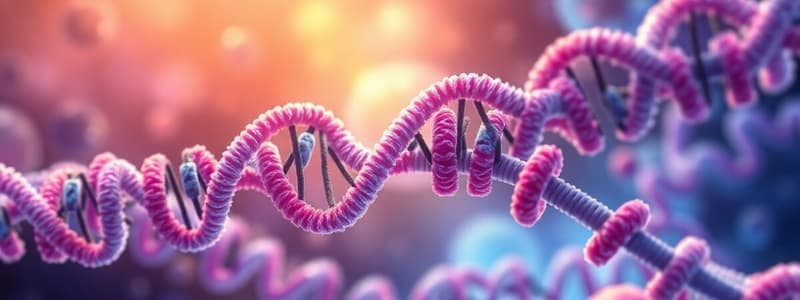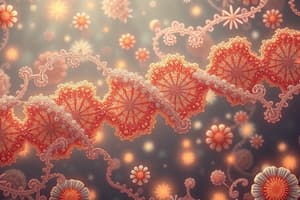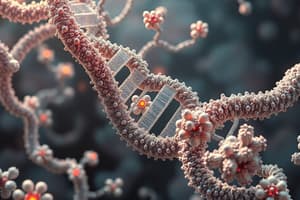Podcast
Questions and Answers
What is the primary function of transcription factors in eukaryotic transcription?
What is the primary function of transcription factors in eukaryotic transcription?
- They bind to the RNA transcript to prevent degradation.
- They catalyze the synthesis of RNA from DNA directly.
- They assist in the folding of newly synthesized RNA strands.
- They help to regulate gene expression by forming a complex with RNA polymerase II. (correct)
In eukaryotic cells, which of the following accurately describes RNA polymerase II?
In eukaryotic cells, which of the following accurately describes RNA polymerase II?
- It incorporates nucleotides into RNA without the need for a template strand.
- It requires a complex of general transcription factors to initiate transcription. (correct)
- It is the only type of RNA polymerase present in eukaryotes.
- It synthesizes RNA in the 3’-to-5’ direction.
Which component of the eukaryotic transcription initiation complex is specifically responsible for recognizing the core promoter?
Which component of the eukaryotic transcription initiation complex is specifically responsible for recognizing the core promoter?
- TFIE
- TFIID (correct)
- TFIIF
- TFIIA
What direction is RNA synthesized during transcription in eukaryotic cells?
What direction is RNA synthesized during transcription in eukaryotic cells?
Which of the following best describes the role of TFIID in the transcription process?
Which of the following best describes the role of TFIID in the transcription process?
What is the primary role of the core promoter in eukaryotic transcription?
What is the primary role of the core promoter in eukaryotic transcription?
Which of the following statements about the TATA box is correct?
Which of the following statements about the TATA box is correct?
What role does the Downstream Promoter Element (DPE) serve in eukaryotic transcription?
What role does the Downstream Promoter Element (DPE) serve in eukaryotic transcription?
Which consensus sequence corresponds to the Initiator Element (INR)?
Which consensus sequence corresponds to the Initiator Element (INR)?
Which element is commonly flanked by the B recognition element (BRE) in human promoters?
Which element is commonly flanked by the B recognition element (BRE) in human promoters?
What type of RNA polymerase is responsible for the transcription of all types of RNA in prokaryotes?
What type of RNA polymerase is responsible for the transcription of all types of RNA in prokaryotes?
Which transcription factor is essential at the core promoter for the initiation of transcription by RNA polymerase II?
Which transcription factor is essential at the core promoter for the initiation of transcription by RNA polymerase II?
Which strand of DNA is used as the template for RNA synthesis?
Which strand of DNA is used as the template for RNA synthesis?
What is the primary role of transcription factors in the transcription process?
What is the primary role of transcription factors in the transcription process?
How many different RNA polymerases are present in eukaryotic cells?
How many different RNA polymerases are present in eukaryotic cells?
What is the end product of transcription in eukaryotic cells?
What is the end product of transcription in eukaryotic cells?
Which component is required during translation to synthesize proteins?
Which component is required during translation to synthesize proteins?
Which of the following correctly distinguishes the sense and antisense strands of DNA?
Which of the following correctly distinguishes the sense and antisense strands of DNA?
What is transcripted by RNA polymerase II during gene transcription?
What is transcripted by RNA polymerase II during gene transcription?
What is replaced in RNA during the process of transcription compared to DNA?
What is replaced in RNA during the process of transcription compared to DNA?
Which statement correctly describes eukaryotic RNA polymerases?
Which statement correctly describes eukaryotic RNA polymerases?
What is the role of transcription factors in eukaryotic transcription?
What is the role of transcription factors in eukaryotic transcription?
Which component specifically initiates the assembly of other transcription factors and RNA polymerase II?
Which component specifically initiates the assembly of other transcription factors and RNA polymerase II?
In which direction is RNA synthesized during transcription?
In which direction is RNA synthesized during transcription?
What is the function of the TATA-binding protein (TBP) within TFIID?
What is the function of the TATA-binding protein (TBP) within TFIID?
What is the approximate length of the promoter region in base pairs?
What is the approximate length of the promoter region in base pairs?
Which of the following elements is primarily recognized by the transcription factor TATA-binding protein?
Which of the following elements is primarily recognized by the transcription factor TATA-binding protein?
What is the location of the Downstream promoter element (DPE) relative to the transcription start site?
What is the location of the Downstream promoter element (DPE) relative to the transcription start site?
Which consensus sequence is associated with the Initiator element (INR)?
Which consensus sequence is associated with the Initiator element (INR)?
In relation to the transcription start site (TSS), where is the core promoter generally found?
In relation to the transcription start site (TSS), where is the core promoter generally found?
Which molecule is required for the synthesis of proteins during translation?
Which molecule is required for the synthesis of proteins during translation?
During transcription, what is replaced in RNA compared to DNA?
During transcription, what is replaced in RNA compared to DNA?
What initiates transcription by binding to the promoter region of DNA?
What initiates transcription by binding to the promoter region of DNA?
What is the starting material required for translation?
What is the starting material required for translation?
Which of the following statements accurately describes RNA polymerase in eukaryotic cells?
Which of the following statements accurately describes RNA polymerase in eukaryotic cells?
What is the role of general transcription factors in the transcription process?
What is the role of general transcription factors in the transcription process?
What does the TFIID complex specifically recognize in the transcription initiation process?
What does the TFIID complex specifically recognize in the transcription initiation process?
Which part of the DNA strand is referred to as the template strand during RNA synthesis?
Which part of the DNA strand is referred to as the template strand during RNA synthesis?
Which of the following best describes the function of transcription factors in eukaryotic cells?
Which of the following best describes the function of transcription factors in eukaryotic cells?
Flashcards
Eukaryotic RNA Polymerase
Eukaryotic RNA Polymerase
Enzymes that synthesize RNA from a DNA template in eukaryotes, having three types (I, II, III).
Transcription Factors
Transcription Factors
Proteins that bind to DNA promoter regions, helping RNA polymerase to initiate transcription.
General Transcription Factors (GTFs)
General Transcription Factors (GTFs)
A group of transcription factors required for RNA polymerase II-mediated transcription initiation.
TFIID
TFIID
Signup and view all the flashcards
RNA template strand
RNA template strand
Signup and view all the flashcards
Eukaryotic Gene Promoter
Eukaryotic Gene Promoter
Signup and view all the flashcards
Core Promoter Element
Core Promoter Element
Signup and view all the flashcards
TATA Box
TATA Box
Signup and view all the flashcards
Initiator Element (INR)
Initiator Element (INR)
Signup and view all the flashcards
Downstream Promoter Element (DPE)
Downstream Promoter Element (DPE)
Signup and view all the flashcards
From Genes to Proteins
From Genes to Proteins
Signup and view all the flashcards
Transcription
Transcription
Signup and view all the flashcards
Translation
Translation
Signup and view all the flashcards
Sense Strand
Sense Strand
Signup and view all the flashcards
Antisense Strand
Antisense Strand
Signup and view all the flashcards
RNA Polymerase in Eukaryotes
RNA Polymerase in Eukaryotes
Signup and view all the flashcards
Transcription Factors: The Helpers
Transcription Factors: The Helpers
Signup and view all the flashcards
TFIID: The Core Promoter Recognizer
TFIID: The Core Promoter Recognizer
Signup and view all the flashcards
Template Strand: The 'Guide'
Template Strand: The 'Guide'
Signup and view all the flashcards
RNA Polymerase in Transcription
RNA Polymerase in Transcription
Signup and view all the flashcards
Core Promoter
Core Promoter
Signup and view all the flashcards
Promoter Region
Promoter Region
Signup and view all the flashcards
What is the central dogma?
What is the central dogma?
Signup and view all the flashcards
Sense vs. Antisense
Sense vs. Antisense
Signup and view all the flashcards
RNA Polymerase
RNA Polymerase
Signup and view all the flashcards
RNA Polymerase Direction
RNA Polymerase Direction
Signup and view all the flashcards
Template Strand
Template Strand
Signup and view all the flashcards
Study Notes
Eukaryotic Gene Transcription and Translation
- Eukaryotic gene transcription and translation is a complex process occurring in the nucleus and cytoplasm respectively
- This involves multiple steps, including DNA transcription into RNA (messenger RNA, mRNA), mRNA processing, and translation of mRNA into protein in the ribosomes
Molecular Mechanisms of Disease
- The diagram shows a eukaryotic cell with various organelles including: the nucleus, endoplasmic reticulum (rough and smooth), cytoskeleton, mitochondria, and ribosomes
- Components found in the nucleus include chromatin, nuclear pore, nuclear envelope, nucleolus, and glycogen granules
- Cytoskeleton components include microtubules, microfilaments, intermediate filaments, and also microvilli, centrosome, and centriole
- Other organelles identified in the cell include: plasma membrane, secretory vesicles, lysosome, peroxisome
- Flagellum and Cillum are components of the cell
Transcription
- Transcription is the synthesis of messenger RNA (mRNA) from a DNA template in the nucleus
- Starting materials include DNA as the template, and required machinery such as RNA polymerase II and transcription factors
- End product: messenger RNA (mRNA) after processing
Translation
- Translation is the synthesis of proteins in the cytoplasm, using information encoded by messenger RNA (mRNA)
- Starting materials include mRNA, required machinery such as ribosomal RNA (rRNA), ribosomal proteins, and transfer RNA (tRNAs)
- End product: polypeptide
Sense vs Antisense DNA Strands
- The coding strand (sense strand) has the same sequence as the mRNA, except thymine is replaced by uracil
- The template strand (antisense strand) dictates the sequence of the mRNA during transcription
Transcription - Both Strands Encode Genes
- DNA has 3.6 x 104 base pairs
- Both DNA strands are transcribed although only one strand serves as a template for the first mRNA sequence being created
Transcription - RNA Polymerase
- RNA polymerase binds to DNA, initiates transcription at a promoter region, and incorporates nucleotides into a complementary RNA strand from the template strand
- Eukaryotes have three slightly different RNA Polymerases (I, II, III) that handle different types of RNA
- RNA polymerase I is responsible for most ribosomal RNA
- RNA polymerase II is responsible for mRNA transcripts
- RNA polymerase III is involved in producing tRNA and 5S rRNA
Eukaryote Transcription - Core Promoter
- The core promoter is the site on DNA where RNA polymerase binds before initiating transcription
- Key elements include: -TATA box -Initiator element (INR) -Proximal promoter element -Downstream promoter element (DPE)
- These elements are within about 250 base pairs of the transcription start site.
Eukaryote Transcription - Enhancer Regions
- These regions can be upstream (up to 50,000 base pairs) or downstream of the start site
- Enhancers enhance the rate of transcription by binding transcription factors that interact with the pre-initiation complex of the promoter region of a gene.
Eukaryote Transcription - Pre-Initiation Complex (PIC)
- A complex of approximately 100 proteins necessary for transcription of protein-coding genes in eukaryotes
- Components include:
- TFIID
- RNA polymerase II
- TFIIB
- TFIIA
Eukaryote Transcription - Elongation
- Extension of the RNA transcript using the DNA template by RNA Polymerase II
- RNA polymerase incorporates 20-50 nucleotides into the RNA molecule per second
- The region of unwound DNA is ~13 bp wide and is called the transcription bubble
- During elongation, the transcription bubble moves along the DNA, unwinding and rewinding it as needed, relieved by topoisomerases
Eukaryote Transcription - Termination
- In eukaryotes, there is no well-defined sequence for termination
- Termination in eukaryotes is often associated with polyadenylation signal sequence (PAS) often appearing as AAUAAA
- This region of RNA determines the ultimate length of the mRNA by processing steps, followed by addition of Adenosines at the 3' end -> polyadenylation
- The AAUAAA sequence is found well past the end of coding region leading to the poly-A tail
Studying That Suits You
Use AI to generate personalized quizzes and flashcards to suit your learning preferences.




